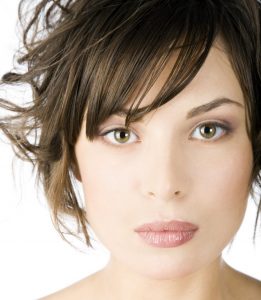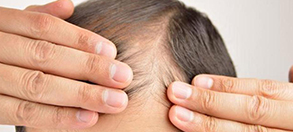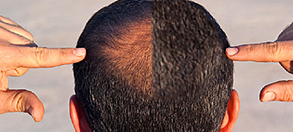When we hear about hair loss in advertisements, it’s most often about men losing their hair. Creams, shampoos, and supplements are all geared toward male pattern baldness, but what many don’t realize is how common thinning hair is for women as well.
 While pattern baldness is often seen as a product of aging or genetics, what causes hair loss in women can sometimes be explained by things we cannot otherwise see. Sometimes, female baldness is merely a symptom of a larger problem at bay.
While pattern baldness is often seen as a product of aging or genetics, what causes hair loss in women can sometimes be explained by things we cannot otherwise see. Sometimes, female baldness is merely a symptom of a larger problem at bay.
We’re proud to be the hair transplant surgeons of choice for pro athletes, actors & celebrities.
Women (like men) are oftentimes embarrassed by their hair loss and are quick to search for reasons their hair is falling out. They may change their diets, ask their doctor to run blood work, or start buying special (and expensive) shampoos to try to reverse the effects. When all else fails, they may start looking into wigs.
The good news is that there are quite a few reasons your hair could be thinning, and there are oftentimes ways of treating it, but you need to find a solution that works for your specific situation.
Here are some of the causes of hair loss in women — and how you can treat your thinning hair appropriately.
8 Causes of Hair Loss in Women (And How to Treat Each)
1. Genetics – Androgenic Alopecia (Female Pattern Hair Loss)
Thinning hair that cannot be explained by a medical condition is called androgenic alopecia. This simply refers to a hereditary predisposition to hair loss.
Due to the overwhelming number of hair loss ads aimed at men, and perhaps the stigma associated with hair loss in woman, many people may not realize that female pattern baldness (also called female pattern hair loss) is just as common as male pattern baldness, but they don’t follow the same pattern.
While men tend to experience hair loss beginning at the forehead and/or crown of the head, women are more likely to experience thinning hair at the top of the head — usually in the top third or half of the scalp.
 Most women may not even notice excessive hair loss at first. According to the American Academy of Dermatology, it’s normal to lose between 50 and 100 strands of hair per day. It falls out naturally when it’s washed, brushed, and styled.
Most women may not even notice excessive hair loss at first. According to the American Academy of Dermatology, it’s normal to lose between 50 and 100 strands of hair per day. It falls out naturally when it’s washed, brushed, and styled.
So when hair loss begins for women, they may simply think they’re shedding a bit more than usual — perhaps they’re noticing more hair loss while in the shower or while brushing their hair. In fact, there’s not necessarily cause for alarm at first. It could simply be excessive hair shedding (the medical term is telogen effluvium, caused by a number of things, such as illness, stress, or giving birth to a child).
Excessive hair shedding becomes most noticeable when the scalp becomes more visible. According to Dr. Nicole Rogers, “Women may see a part [in their hair] that is gradually becoming wider or see more of their scalp than normal when their hair is pulled back.”
If this is something you notice on your own scalp, trying oral medications like finasteride or topical minoxidil can be part of your treatment plan, but another solution is hair transplant services.
How to Treat Female Pattern Baldness
Back in the day, people were more hesitant to treat their pattern baldness with hair transplant surgery because it typically involved having a linear strip cut from their scalp and then moved to other parts of their head. As a result, the scalp would have to be stretched so it could be sewn back together, oftentimes making it seem as though people had thinner hair than they actually did.
As with most other things in the 21st century, technology has helped us along. Now, we can perform a procedure called follicular unit extraction (FUE), allowing us to move single hair follicles to other parts of the head or face. This procedure is extremely difficult and tedious, but usually comes with incredible results.
During this procedure, the surgeon takes hair follicles from portions of your scalp that are most densely populated. The surgeon can take up to 20% of those follicles before it becomes noticeably thinner, and most will stop at about 15%. At that point, the follicles are moved to portions of the scalp where the patient would like more hair growth.
These results are indeed permanent, in that the follicle continues to grow the strand of hair as if it had never been disturbed. No new hair will grow in the donor site, but if the surgeon stayed within the threshold, it won’t be noticeable at all — probably not even to you.
If FUE is something you’re interested in to treat your thinning hair, contact us today for a consultation. We’d love to help you become a more confident version of yourself!
2. Thyroid Conditions
 The thyroid controls our heart rates and calorie-burn, and when it’s out of whack, it can cause a whole host of problems. Of course, one of them is thinning hair. Both a slow thyroid (hypothyroidism) and a fast thyroid (hyperthyroidism) can cause hair loss in women and men, in addition to changes in hair texture.
The thyroid controls our heart rates and calorie-burn, and when it’s out of whack, it can cause a whole host of problems. Of course, one of them is thinning hair. Both a slow thyroid (hypothyroidism) and a fast thyroid (hyperthyroidism) can cause hair loss in women and men, in addition to changes in hair texture.
While hyper- and hypothyroid are perhaps the most well-known thyroid conditions, they aren’t the only disorders that affect this pesky gland. Hashimoto’s thyroiditis is a common autoimmune disorder in which the body attacks the thyroid, and is most commonly found in middle-aged women — though it can be found in both men and younger women.
Treatment for any thyroid disorder typically includes medication. The tricky part is the diagnosis, which is sometimes elusive — particularly for some of the rarer diseases. However, once a diagnosis is made, a treatment plan can be developed and is often quite effective, at which point, most women’s hair grows back and returns to normal.
3. Polycystic Ovary Syndrome (PCOS)
PCOS is a common hormonal disorder affecting women mostly during their reproductive years. In this case, PCOS causes an excess of androgen levels (male sex hormones). Excess androgens can go one of three ways:
- 1. The woman could grow more facial and body hair, or
- 2. The woman could experience hair loss, or
- 3. Both.
When hair loss in women is caused by PCOS, it’s actually classified as male pattern baldness because androgen is the hormone in men that often causes thinning hair. Therefore, the treatment for this type of hair loss is the same as pattern baldness: oral finasteride, topical minoxidil, and/or hair transplant services.
4. Lupus
Lupus is a very complex, but relatively common autoimmune disorder that can affect many areas of the body, including joints, skin, and major internal organs and vessels. While both women and men can have lupus, it’s more commonly found in women.
The diagnosis for lupus iother common diseases obtain because it shares so many symptoms with other common disease (it is one of a few diseases often referred to as Great Imitators due to their diagnostic complexity). While there is no cure for lupus (and the cause is unknown), it can oftentimes be managed with medication, and once it’s under control, hair loss should minimize and regrowth can begin.
5. Iron-Deficient Anemia
A common side effect of iron-deficient anemia (there are many types of anemia) is hair loss — and like many other diseases on this list, this type of anemia is most often found in women. A simple blood test can determine if you’re anemic.
Luckily, the treatment is relatively easy: you take an iron supplement. The only thing to keep in mind is that some women report nausea with iron pills, so you may have to try a few different brands, or eat something light when you take it (read the directions on the bottle for maximum effect of the pill).
6. Severe Stress or Anxiety Disorders
When people experience chronic stress, it sometimes manifests itself in physical ways. We commonly hear about weight gain or loss, but thinning hair is another symptom. Sometimes, it’s so gradual the person may not notice it until they have substantial hair loss, or the hair begins to grow back (resulting in patches of very short hair next to longer hair).
Treatment for chronic stress and anxiety typically involves cognitive behavioral therapy, and sometimes medication. In this case, hair regrowth is often possible as long as the stressors can be managed and largely avoided in the future.
In addition, temporary hair loss can be a result of temporary stress. In these cases, the thinning hair resolves itself when the stressor is eliminated.
If you think you may be suffering from any of these diseases, you should speak to your doctor. He or she can run a blood panel and refer you to a specialist, if necessary.
7. Medication
A whole host of medications have hair loss listed as a side effect. The list is long, but here are a few of the most common:
- Retinoids
- Antidepressants
- Statins
- Birth control pills
- Immunosuppressants
- Beta-blockers
- Steroids
- Thyroid medications
This type of hair loss in women should be easily remedied by switching medications — if that’s a possibility for your condition. Each medication will have a slightly different formula, and it’s possible that one drug works better for you than another.
8. Alopecia Areata
Alopecia areata is an autoimmune disorder, which is a type of disease in which the body attacks itself. So in this case, the body attacks hair follicles, causing the hair in those follicles to fall out — oftentimes in clumps.
Every case of alopecia areata is different, so it’s difficult to say how any given person will experience hair loss. Most people lose chunks in random places on the scalp, but in rare cases, people lose all the hair on their heads, and sometimes on their bodies. While there is no cure for this disease, hair often grows back with treatment.
Common treatments include corticosteroids, immunotherapy (designed to create an allergic reaction, which actually causes the hair to grow back), and topical minoxidil (Rogaine).



